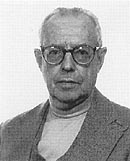Thoughts on the 40th Anniversary of ABCC/RERF
by Gilbert W Beebe
Chief, Department of Statistics, 1958-60, 1966-68
Chief, Department of Epidemiology and Statistics, 1973-75,
Permanent Director and Chief of Research, 1975

Gilbert W Beebe
In November 1945, for the monthly report “Health of the Army,” for which I was responsible, I interviewed Colonel Ashley W. Oughterson on his return from duty in Japan with the Joint Commission for the Investigation of the Effects of the Atomic Bombs in Japan. Little did I realize then how closely my scientific career would come to be tied to the investigation of those effects. Some months later, when the Committee on Veterans’ Medical Problems of the National Research Council (NRC) was assessing the opportunity for a research program to be built on the medical experience of US military personnel in World War II, Col. Oughterson provided the Committee with a copy of his historic memorandum to Army Surgeon General Kirk on the importance of long-term studies of the A-bomb survivors in Japan. Sponsorship of these studies fell to another NRC committee, the Committee on Atomic Casualties (CAC), organized in response to the Navy Department memorandum (prepared by Dr. Shields Warren) that President Truman initialed on 26 November 1946, to give it the effect of an Executive Order to the National Academy of Sciences to institute studies with the cooperation of the Federal agencies. The Committee on Veterans’ Medical Problems confined its attention to studies of US war veterans conducted through its Medical Follow-up Agency with which Seymour Jablon and I became associated.
Discussions among the staff of the NRC Division of Medical Sciences, where both committees were located, provided both Seymour Jablon and myself with enough information on the CAC and the Atomic Bomb Casualty Commission that it sponsored in Japan so that we knew about the early findings with respect to leukemia by 1951 and had come to realize that CAC was mainly intent on building and administering the research organization (ABCC) in Japan and had given little attention to the development of a long-term research strategy. With the arrival in Washington of the Woodbury-Maki report on death rates in Hiroshima, epidemiologic issues came to the fore and influenced the composition of the team Dr. R. Keith Cannan selected for the site-visit that led to the Francis Report in 1955. Mr. Jablon’s role in that visit and in subsequent efforts to implement the recommendations of the Francis Report led finally to Dr. Cannan’s selection of the Medical Follow-up Agency to take the leadership role in statistics at ABCC in parallel with Yale in medicine and the University of California at Los Angeles in pathology. This new responsibility brought me to Japan for the first time, and I served three two-year tours at ABCC, 1958-60, 1966-68, and 1973-75, as head of the statistics department (later the department of epidemiology and statistics). Mr. Jablon served two three-year terms in this capacity, 1960-63, and 1969-72; other members of the Agency staff also served a total of 12 man-years on the staff of the department. Near the end of my last tour the Government of Japan and the Government of the United States agreed to replace ABCC with RERF, the Crow Commission reviewed the ABCC program for the National Academy of Sciences, and I accepted the additional responsibility of Chief Scientist until a more permanent appointment could be made. Since my retirement from the National Academy of Sciences in 1977 I have had no official connection with RERF but have remained actively interested, have visited several times, and have made extensive use of RERF findings. I also helped to establish the present link between the National Cancer Institute and RERF through a contract between the Institute and the Academy.
This article was originally published in RERF Newsletter 14 (40th anniversary special issue):16-17, 1988.

